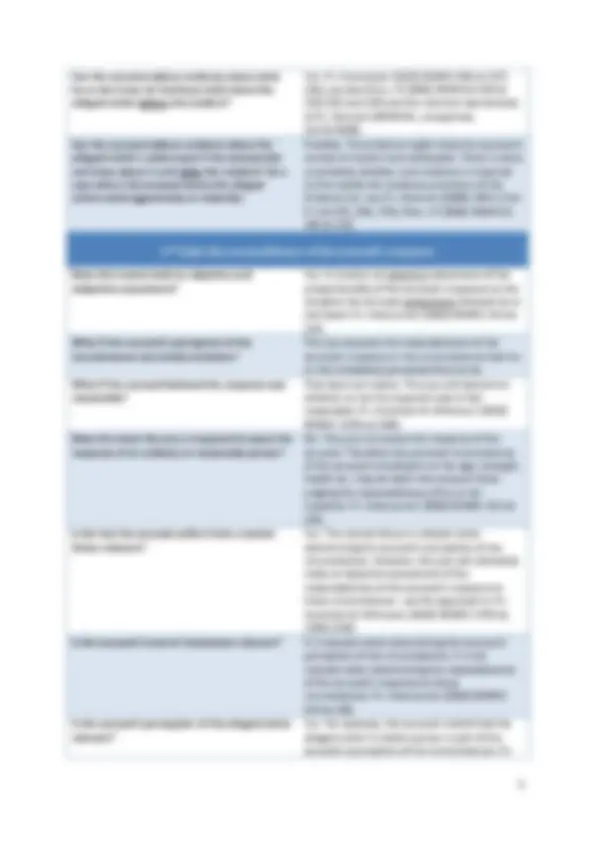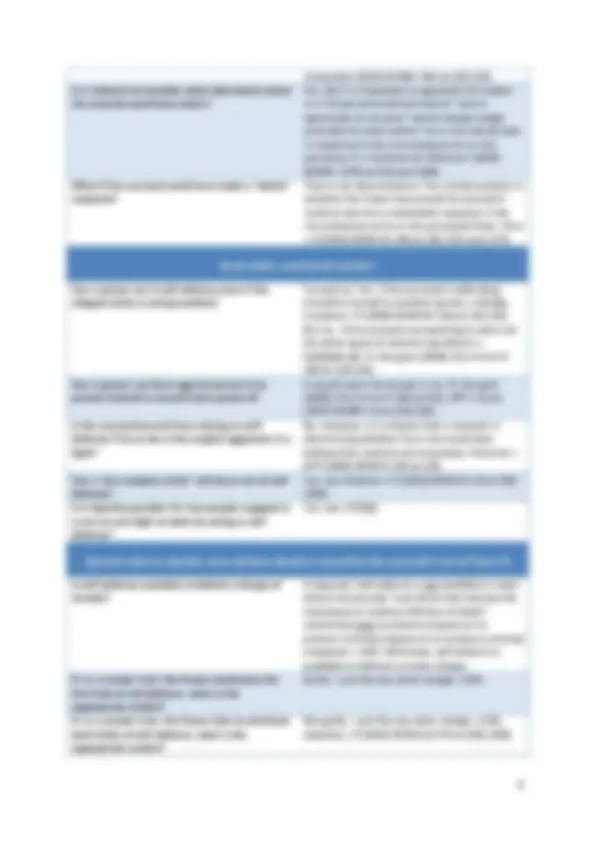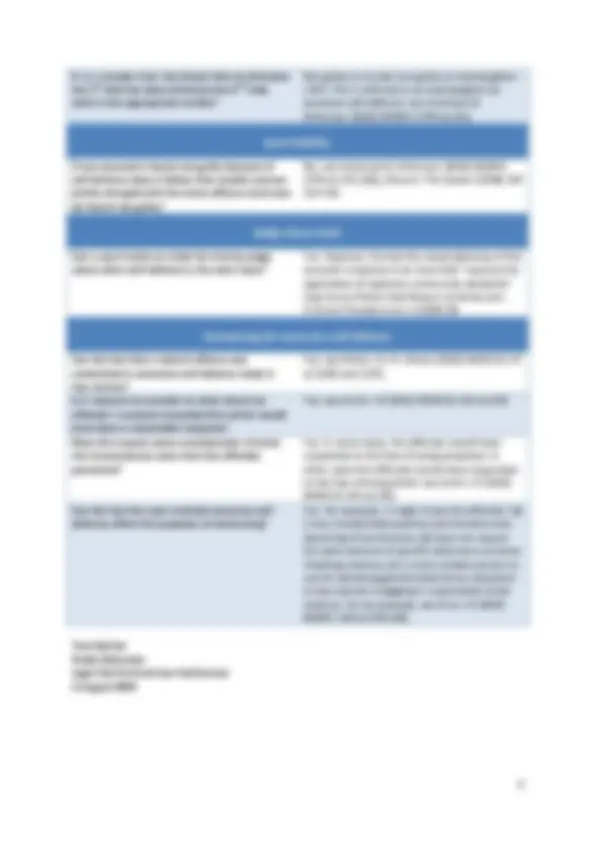





Study with the several resources on Docsity

Earn points by helping other students or get them with a premium plan


Prepare for your exams
Study with the several resources on Docsity

Earn points to download
Earn points by helping other students or get them with a premium plan
Community
Ask the community for help and clear up your study doubts
Discover the best universities in your country according to Docsity users
Free resources
Download our free guides on studying techniques, anxiety management strategies, and thesis advice from Docsity tutors
An overview of the self-defence law in Australia, covering the sources of the law, standard self-defence directions, the recognition of self-defence conduct, the onus of proof, raising self-defence, and the reasonableness of the response. It also discusses the applicability of self-defence in various scenarios, such as defending others, preventing criminal trespass, and protecting property.
What you will learn
Typology: Study Guides, Projects, Research
1 / 5

This page cannot be seen from the preview
Don't miss anything!




Sources Where is the law on self-defence found? Crimes Act 1900 NSW ss 418-423. When did those sections commence? 2002. Therefore earlier common law decisions about self-defence such as Zecevic v DPP (1987) 162 CLR 645 should be read with caution. What about for Commonwealth offences? Criminal Code 1995 Cth ss 10.4 and 13.3. Are there standard self-defence directions in the NSW Criminal Trial Benchbook? Yes. Fundamental rules Does the law recognise that a person may carry out conduct in self-defence? Yes: s 418. What happens if a Court concludes a person carried out conduct constituting an offence in self-defence? The person is not criminally responsible for such an offence: s 418(1). What are the two pre-conditions to a conclusion that a person carried out conduct in self- defence? (1) the person believes his or her conduct was necessary in order to defend himself or herself; and (2) the person’s conduct was a reasonable response in the circumstances as he or she perceived them: s 418(2). Does the Act specify from what a person may defend himself or herself? No: s 418(2). It does not express, for example, a person may only defend himself or herself from a physical as distinct from a verbal or mental attack. Is self-defence limited to literally defending yourself? No. Self-defence also includes conduct necessary to: (a) defend another person; (b) prevent or terminate the unlawful deprivation of liberty; (c) protect property from unlawful taking, destruction, damage or interference; (d) prevent criminal trespass to any land or premises or to remove a person committing any such criminal trespass: s 418(2). Onus of proof when self-defence is “raised” Does the crown have the onus of proving a person did not act in self-defence? Yes, provided the issue is raised: s 419. What does the Crown have to prove? The Crown must prove beyond reasonable doubt either: (1) the accused did not believe his or her conduct was necessary to defend himself or herself; or (2) the conduct by the accused was not a reasonable response in the circumstances as he or she perceived them. Does the Crown need to prove both matters or “limbs” set out above? No. The Crown will succeed in proving a person did not act in self-defence if it proves either matter beyond reasonable doubt: s 418(2). However, there are special rules in murder cases (see below).
What does it mean to “raise” self-defence? Although not stated in the section, the issue must be raised by evidence during the trial: Sivaraja v R; Sivathas v R [2017] NSWCCA 236 at [123]-[124]. What standard must the evidence reach before self-defence is raised? There must be some evidence capable of supporting a reasonable doubt in relation to both limbs of self-defence. In considering this question, the evidence should be taken at its highest in favour of the accused: Sivaraja v R; Sivathas v R [2017] NSWCCA 236 at [123]-[124]. Does the accused need to give evidence in order to raise self-defence? No. Inferences about an accused’s belief etc. may be drawn from any source of evidence: Colosimo v DPP [2006] NSWCA 203 at [19]. Can a judge refuse to leave self-defence to the jury if it is not “raised” by the evidence? Yes: Sivaraja v R; Sivathas v R [2017] NSWCCA 236 at [146]. What if the accused does not claim self-defence because, for example, he or she denies being present when the incident occurred? There may still be an obligation on the trial judge to leave self-defence to the jury if the issue arises on the evidence: James v The Queen (2014) 253 CLR 475 at [31]; Flanagan v R (2013) 236 A Crim R 255 at [76]-[84]. 1 st^ limb: the accused’s belief about the necessity of carrying out the conduct Does it matter when the accused held a belief that his or her conduct was necessary? Yes. It only matters what the accused’s belief was at the time he or she carried out the conduct. It does not matter if, in hindsight, the accused realises such conduct was not actually necessary: R v Katarzynski [2002] NSWSC 613 at [23]; see also the common law case of R v Conlon (1993) 69 A Crim R 92 at 96. Does it matter if the accused’s belief is unreasonable? No. The critical question is whether or not the accused honestly believed the conduct was necessary: R v Katarzynski [2002] NSWSC 613 at [24]; Abdallah v R [2016] NSWCCA 34 at [62] and [74]. Should the accused’s personal characteristics or personal history be taken into account when assessing his or her belief? Yes. For example, the accused’s past experiences may inform his or her belief about what conduct was necessary: R v Hutchison & Wilkinson [2018] NSWSC 1759 at [307]. Should a mental illness suffered by the accused be taken into account when assessing his or her belief? Yes: R v Hutchison & Wilkinson [2018] NSWSC 1759 at [303] and [307]. Is the accused’s level of intoxication relevant to an assessment of his or her belief? Yes: R v Katarzynski [2002] NSWSC 613 at [28]. Is the accused’s belief about the particular alleged victim relevant? Yes. For example, the accused’s belief the alleged victim is violent, erratic, ruthless, powerful, prone to carrying arms etc. may inform his or her belief that certain conduct was necessary: R v Castaneda [2015] NSWSC 964 at [17]-[26]; Elias v R [2006] NSWCCA 365 at [38].
Castaneda [2015] NSWSC 964 at [24]-[26]. Is it relevant to consider what alternative action the accused could have taken? Yes. But it is important to approach the matter in a “broad and practical manner” and to appreciate an accused “cannot always weigh precisely the exact action” he or she should take in response to the circumstances he or she perceives: R v Hutchison & Wilkinson [2018] NSWSC 1759 at [43] and [309]. What if the accused could have made a “better” response? That is not determinative. The critical question is whether the Crown has proved the accused’s conduct was not a reasonable response in the circumstances as he or she perceived them: Silva v R [2016] NSWCCA 284 at [34]-[35] and [171]. Some other contextual matters Can a person act in self-defence even if the alleged victim is acting lawfully? Yes and no. Yes - if the accused is defending himself or herself or another person: s 422(a); Crawford v R [2008] NSWCCA 166 at [21]-[25]. But no - if the accused is purporting to carry out the other types of conduct specified in s 418(2)(b)-(d): R v Burgess (2005) 152 A Crim R 100 at [12]-[15]. Can a person use force against person A to protect himself or herself from person B? It would seem the answer is no: R v Burgess (2005) 152 A Crim R 100 at [53]; DPP v Evans [2017] NSWSC 33 at [53]-[56]. Is the accused barred from relying on self- defence if he or she is the original aggressor in a fight? No. However, it is a factor that is relevant in determining whether he or she could have believed the conduct was necessary: Colosimo v DPP [2006] NSWCA 203 at [19]. Can a “pre-emptive strike” still be an act of self- defence? Yes: see Abdallah v R [2016] NSWCCA 34 at [98]- [100]. Is it logically possible for two people engaged in a one on one fight to both be acting in self- defence? Yes: see s 422(b). Special rules in murder cases (where death is caused by the accused’s use of “force”) Is self-defence available to defend a charge of murder? It depends. Self-defence is not available in cases where the accused “uses force that involves the intentional or reckless infliction of death” committed only to protect property or to prevent criminal trespass or to remove a criminal trespasser: s 420. Otherwise, self-defence is available to defend a murder charge. If, in a murder trial, the Crown eliminates the first limb of self-defence, what is the appropriate verdict? Guilty – just like any other charge: s 418. If, in a murder trial, the Crown fails to eliminate both limbs of self-defence, what is the appropriate verdict? Not guilty – just like any other charge: s 418; Abdallah v R [2016] NSWCCA 275 at [98]-[100].
If, in a murder trial, the Crown fails to eliminate the 1st^ limb but does eliminate the 2nd^ limb, what is the appropriate verdict? Not guilty to murder but guilty to manslaughter: s 421. This is referred to as manslaughter by excessive self-defence: see Hutchison & Wilkinson [2018] NSWSC 1759 at [41]. Joint liability If one accused is found not guilty because of self-defence does it follow that another person jointly charged with the same offence must also be found not guilty? No: see Hutchison & Wilkinson [2018] NSWSC 1759 at [17]-[20]; Osland v The Queen (1998) 197 CLR 316. Judge alone trials Can a court make an order for trial by judge alone when self-defence is the main issue? Yes. However, the fact the reasonableness of the accused’s response is an issue that “requires the application of objective community standards” may be one factor that favours a trial by jury: Criminal Procedure Act s 132(4)-(5). Sentencing for excessive self-defence Can the fact that a violent offence was committed in excessive self-defence make it less serious? Yes: see Matia v R; R v Matia [2015] NSWCCA 79 at [130] and [137]. Is it relevant to consider to what extent an offender’s conduct exceeded that which would have been a reasonable response? Yes: see Smith v R [2015] NSWCCA 193 at [59]. Does this require some consideration of what the circumstances were that the offender perceived? Yes. In some cases, the offender would have responded to the fear of being assaulted. In other cases the offender would have responded to the fear of being killed: see Smith v R [2015] NSWCCA 193 at [59]. Can the fact the case involved excessive self- defence affect the purposes of sentencing? Yes. For example, it might mean the offender: (a) is less morally blameworthy and therefore less deserving of punishment; (b) does not require the same amount of specific deterrence as those initiating violence; (c) is a less suitable person to use for achieving general deterrence compared to say a person engaging in unprovoked street violence. For an example, see Silva v R [2015] NSWSC 148 at [59]-[60]. Tom Quilter Public Defender Legal Aid Criminal Law Conference 2 August 2019